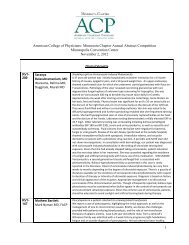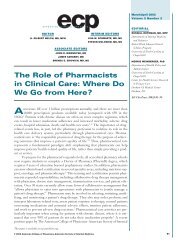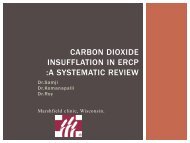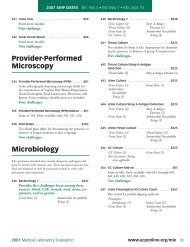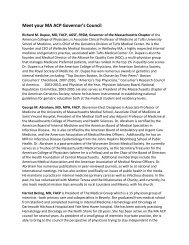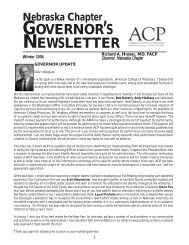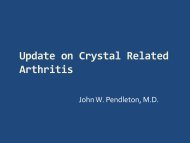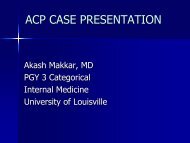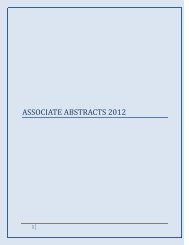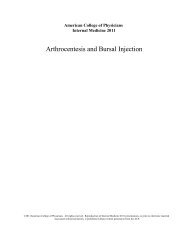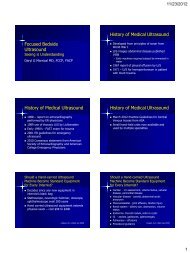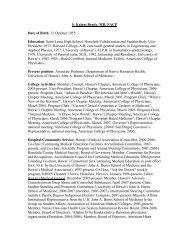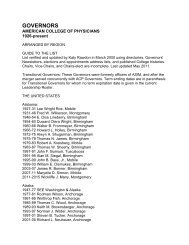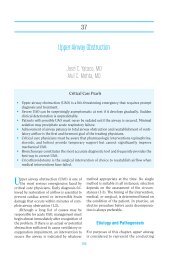Anaplasmosis as a Mimicker of TTP/HUS - American College of ...
Anaplasmosis as a Mimicker of TTP/HUS - American College of ...
Anaplasmosis as a Mimicker of TTP/HUS - American College of ...
You also want an ePaper? Increase the reach of your titles
YUMPU automatically turns print PDFs into web optimized ePapers that Google loves.
<strong>TTP</strong> or not <strong>TTP</strong>?<br />
Joshua Baroc<strong>as</strong> , MD<br />
Saurabh Rajguru, MD<br />
The University <strong>of</strong> Wisconsin Hospital and Clinics
C<strong>as</strong>e Presentation<br />
HPI: A 59 y/o male with CAD presents with two days <strong>of</strong><br />
confusion, fevers, unsteady gait and non-bloody diarrhea. He<br />
denies any sick contacts, N/V or abdominal pain.
C<strong>as</strong>e Presentation<br />
PMH:<br />
CAD s/p 4v CABG<br />
HTN<br />
HL<br />
Rheumatic fever <strong>as</strong> a child<br />
FH:<br />
Non-contributory<br />
SH:<br />
Smokes 2-3 cigarettes/day<br />
Drinks 1 gl<strong>as</strong>s <strong>of</strong> wine/wk<br />
Lives in Northern WI with his wife<br />
Allergies:<br />
Niacin<br />
Medications:<br />
Amiodarone<br />
Baby ASA<br />
Lisinopril<br />
Metroprolol<br />
Ezetemibe<br />
Rosuv<strong>as</strong>tatin
Physical Exam<br />
• Vitals: T-100.4, BP-82/48, P-78, RR-16, SpO2-97% on RA<br />
• Gen: awake, alert, some slurring <strong>of</strong> speech<br />
• HEENT: ncat, eomi, anicteric, dry oral mucosa, no pharyngeal<br />
erythema/exudate<br />
• CV: rrr, nl s1s2, no s3/s4, no m/r/g<br />
• Lungs: ctab, no w/r/r<br />
• Abd: s<strong>of</strong>t, nd, nd, no HSM, normal bowel sounds, no<br />
rebound/guarding<br />
• Ext: warm, no c/c/e<br />
• Skin: no r<strong>as</strong>hes, bruises, ecchymoses or petechiae<br />
• Neuro: CN III-XII grossly intact, 5/5 UE/LE strength b/l,<br />
downgoing Babinski, no clonus
Laboratory Assessment<br />
MCV-90.4<br />
14.6<br />
127<br />
93<br />
54<br />
89% PMNs<br />
5.4<br />
42.4<br />
35<br />
4.5<br />
22<br />
4.3<br />
133<br />
6 hrs later<br />
3.8<br />
11.5<br />
33.8<br />
21<br />
131<br />
3.9<br />
102<br />
18<br />
57<br />
4.0<br />
124<br />
*Review <strong>of</strong> peripheral smear revealed very few schistocytes and occ<strong>as</strong>ional Burr cells
Laboratory Assessment<br />
• Tbili-0.9<br />
• AST-181<br />
• ALT-90<br />
• Alk Phos-97<br />
• LDH-619<br />
• D-dimer >3.2<br />
• ADAMSTS13 activity-pending<br />
• von Willebrand factor cleaving prote<strong>as</strong>e<br />
• Function to degrade unusually large von Willebrand factor (ULVWF).<br />
• Deficiency leads to accumulation <strong>of</strong> ULVWF, platelet aggregation, and<br />
subsequent thrombi formation<br />
• Activity level decre<strong>as</strong>ed in <strong>TTP</strong>
Over the next 48 hrs…<br />
• He w<strong>as</strong> given IVF, started on empiric antibiotics<br />
(vancomycin, zosyn, cipr<strong>of</strong>loxacin) and transferred to the<br />
ICU for urgent pl<strong>as</strong>ma exchange<br />
• His mental status began to improve somewhat, even before<br />
pl<strong>as</strong>ma exchange , and his haptoglobin returned normal<br />
(135), so a search for other causes <strong>of</strong> renal failure,<br />
thrombocytopenia and mental status changes w<strong>as</strong> begun
Over the next 48 hrs…<br />
• Now that he w<strong>as</strong> more lucid, further history w<strong>as</strong> obtained:<br />
• revealed that he w<strong>as</strong> bitten a number <strong>of</strong> times by ticks (most<br />
recently a week before presentation)<br />
• He w<strong>as</strong> started empirically on doxycycline<br />
• Testing for ehrlichia, anapl<strong>as</strong>ma and lyme dise<strong>as</strong>e returned<br />
positive for A. phagocytophilum DNA
C<strong>as</strong>e Summary<br />
59 y/o male presents with acute onset thrombocytopenia, renal<br />
failure, fever, altered mental status, and recent tick bites<br />
found to have anapl<strong>as</strong>mosis
Differential <strong>of</strong> <strong>TTP</strong> <strong>Mimicker</strong>s<br />
• Malignant HTN<br />
• Systemic Malignancies<br />
• SLE<br />
• Drugs<br />
– Heparin<br />
– Haldol<br />
– Phenytoin<br />
– Quinine<br />
• DIC<br />
• Systemic Infections<br />
– Anapl<strong>as</strong>ma/Ehrlichia<br />
– Lyme Dise<strong>as</strong>e<br />
– Aspergillus fumigatus<br />
– Rickettsia rickettsii<br />
– E. faecalis<br />
– CMV<br />
– Hepatitis A<br />
– Group A strep<br />
– Candida<br />
– S. aureus<br />
– Bl<strong>as</strong>tomyces<br />
– Cryptococcus<br />
– HIV<br />
Booth KK, Terrell DR, Vesely SK, George JN. Systemic infections mimicking thrombotic thrombocytopenic purpura.<br />
Am. J. Hematol. 2011;86(9):743-751.<br />
Modi KS, Dahl DC, Berkseth RO, Schut R, Greeno E. Human Granulocytic Ehrlichiosis Presenting with Acute Renal<br />
Failure and Mimicking Thrombotic Thrombocytopenic Purpura. Am. J. Nephrology. 1999; 19:677-681.
<strong>TTP</strong>/<strong>HUS</strong> vs. <strong>Anapl<strong>as</strong>mosis</strong><br />
<strong>TTP</strong>/<strong>HUS</strong><br />
• Fever<br />
• AMS/HA<br />
• AKI<br />
• Thrombocytopenia<br />
• MAHA<br />
• Diarrhea<br />
<strong>Anapl<strong>as</strong>mosis</strong><br />
• Fever<br />
• AMS/HA<br />
• AKI<br />
• Thrombocytopenia<br />
• Leukopenia<br />
• Myalgi<strong>as</strong>/arthralgi<strong>as</strong>
Initial Management<br />
• <strong>TTP</strong> suspected<br />
• Pl<strong>as</strong>ma exchange<br />
• Look for other causes<br />
• Tick borne illness<br />
suspected<br />
• Doxycycline 100mg BID<br />
OR<br />
• Rifampin if allergy or<br />
pregnant OR<br />
• Cipr<strong>of</strong>loxacin<br />
Booth KK, Terrell DR, Vesely SK, George JN. Systemic infections mimicking thrombotic thrombocytopenic purpura. Am.<br />
J. Hematol. 2011;86(9):743-751<br />
Rock GA, Shumak KH, Buskard NA, et al. Comparison <strong>of</strong> pl<strong>as</strong>ma exchange with pl<strong>as</strong>ma infusion in the treatment <strong>of</strong><br />
thrombotic thrombocytopenic purpura. New Eng J Med 1991;325:393–397<br />
Clark WF, Garg AX, Blake PG, et al. Effect <strong>of</strong> awareness <strong>of</strong> a randomized controlled trial on use <strong>of</strong> experimental<br />
therapy. JAMA. 2003: 290: 1351-1355<br />
George JN. How I treat patients with thrombotic thrombocytopenic purpura—2010. Blood. 2010;116:4060–4069.<br />
Wormser GP, Dattwyler RJ, Shapiro ED, et al. The clinical <strong>as</strong>sessment, treatment, and prevention <strong>of</strong> lyme dise<strong>as</strong>e,<br />
human granulocytic anapl<strong>as</strong>mosis, and babesiosis: clinical practice guidelines by the Infectious Dise<strong>as</strong>es Society <strong>of</strong><br />
America. Clin. Infect. Dis. 2006;43(9):1089-1134<br />
Woldehiwet Z. In-vitro studies on the susceptibility <strong>of</strong> ovine strains <strong>of</strong> Anapl<strong>as</strong>ma phagocytophilum to antimicrobial<br />
agents and to immune serum. J. Comp. Pathol. 2010;143(2-3):94-100
What to order<br />
• SMEAR (evidence <strong>of</strong> morulae in PMNs)<br />
• Anapl<strong>as</strong>ma/Ehrlichia:<br />
– Serology using indirect flourescent antibody to HME and HGA<br />
– PCR for HME and HGA<br />
– Tissue staining<br />
• Babesia<br />
– Specific Babesia smear<br />
– DNA PCR<br />
• Lyme<br />
– ELISA for IgM and IgG<br />
– Western blot
Epidemiology <strong>of</strong> <strong>Anapl<strong>as</strong>mosis</strong><br />
• Seroprevalence <strong>of</strong> 14.9% among healthy residents from<br />
northwestern Wisconsin who had no h/o a tick bite<br />
• Highest annual avg HGA incidence rates:<br />
• CT (15.9/million), WI (8.8/million), MN (3.9/million), NY<br />
State (2.7/million)<br />
• However, rates <strong>as</strong> high <strong>as</strong> 650/million reported in some NW WI counties<br />
Bakken JS, Dumler S. Human Granulocytic <strong>Anapl<strong>as</strong>mosis</strong>, Infect Dis Clin N Am. 2008; 22, 433-448.<br />
Belongia EA et al. Population-B<strong>as</strong>ed Incidence <strong>of</strong> Human Granulocytic Ehrlichiosis in Northwestern<br />
Wisconsin, 1997-1999, J <strong>of</strong> Inf Dis. 2001; 184 (11), 1470-1474.
No.<br />
No. in parenthesis is mean annual c<strong>as</strong>es/100,000<br />
Belongia E A et al. J Infect Dis. 2001;184:1470-1474<br />
© 2001 by the Infectious Dise<strong>as</strong>es Society <strong>of</strong> America<br />
Belongia EA et al. Population-B<strong>as</strong>ed Incidence <strong>of</strong> Human Granulocytic Ehrlichiosis in Northwestern<br />
Wisconsin, 1997-1999, J <strong>of</strong> Inf Dis. 2001; 184 (11), 1470-1474.
New Ehrlichia Species
New Ehrlichia Species<br />
• Close relative <strong>of</strong> E. muris that w<strong>as</strong> prevalent<br />
throughout Minnesota and Wisconsin.<br />
• Clinically similar to the other forms <strong>of</strong> Ehrlichia and<br />
anapl<strong>as</strong>ma<br />
• Causes fever, malaise, headache, lymphopenia,<br />
thrombocytopenia, and elevated liver-enzymes<br />
• Highly susceptible to doxycycline<br />
• Not yet part <strong>of</strong> the routine send out PCR for ehrlichia<br />
and anapl<strong>as</strong>ma.<br />
• Need to treat in our area if high clinical suspicion for<br />
tick borne illness even in the face <strong>of</strong> a negative PCR.<br />
Pritt BS, Sloan LM, Johnson DKH, et al. Emergence <strong>of</strong> a new pathogenic Ehrlichia species, Wisconsin and<br />
Minnesota, 2009. N. Engl. J. Med. 2011;365(5):422-429
Back to our patient…<br />
• His mental status improved before initiation <strong>of</strong><br />
pl<strong>as</strong>mapheresis and is likely attributable to the empiric<br />
antibiotics he received on presentation (zosyn, cipr<strong>of</strong>loxacin)<br />
and IVF<br />
• After initiation <strong>of</strong> doxycycline, he improved rapidly and left<br />
the ICU after two days<br />
• His ADAMSTS13 activity returned at 70% (nl >67%)<br />
further proving he did not have <strong>TTP</strong><br />
• He w<strong>as</strong> seen by his PCP two weeks after discharge at which<br />
point his plts-332 and Cr-3
Conclusions<br />
• <strong>Anapl<strong>as</strong>mosis</strong> can present with thrombocytopenia, fever,<br />
AMS, AKI, and anemia.<br />
• It can be indistinguishable from <strong>TTP</strong><br />
• Early doxycycline is the mainstay <strong>of</strong> treatment. If <strong>TTP</strong> is still<br />
strongly considered, early pl<strong>as</strong>ma exchange is indicated.<br />
• New species <strong>of</strong> tick borne illness continue to emerge so<br />
clinical suspicion is paramount
References<br />
• Booth KK, Terrell DR, Vesely SK, George JN. Systemic infections mimicking thrombotic thrombocytopenic purpura. Am. J.<br />
Hematol. 2011;86(9):743-751.<br />
• Clark WF, Garg AX, Blake PG, et al. Effect <strong>of</strong> awareness <strong>of</strong> a randomized controlled trial on use <strong>of</strong> experimental therapy. JAMA.<br />
2003: 290: 1351-1355<br />
• George JN. How I treat patients with thrombotic thrombocytopenic purpura—2010. Blood. 2010;116:4060–4069.<br />
• Modi KS, Dahl DC, Berkseth RO, Schut R, Greeno E. Human Granulocytic Ehrlichiosis Presenting with Acute Renal Failure and<br />
Mimicking Thrombotic Thrombocytopenic Purpura. Am. J. Nephrology. 1999; 19:677-681.<br />
• Rock GA, Shumak KH, Buskard NA, et al. Comparison <strong>of</strong> pl<strong>as</strong>ma exchange with pl<strong>as</strong>ma infusion in the treatment <strong>of</strong> thrombotic<br />
thrombocytopenic purpura. New Eng J Med 1991;325:393–397<br />
• Pritt BS, Sloan LM, Johnson DKH, et al. Emergence <strong>of</strong> a new pathogenic Ehrlichia species, Wisconsin and Minnesota, 2009. N.<br />
Engl. J. Med. 2011;365(5):422-429<br />
• Woldehiwet Z. In-vitro studies on the susceptibility <strong>of</strong> ovine strains <strong>of</strong> Anapl<strong>as</strong>ma phagocytophilum to antimicrobial agents and<br />
to immune serum. J. Comp. Pathol. 2010;143(2-3):94-100<br />
• Wormser GP, Dattwyler RJ, Shapiro ED, et al. The clinical <strong>as</strong>sessment, treatment, and prevention <strong>of</strong> lyme dise<strong>as</strong>e, human<br />
granulocytic anapl<strong>as</strong>mosis, and babesiosis: clinical practice guidelines by the Infectious Dise<strong>as</strong>es Society <strong>of</strong> America. Clin. Infect.<br />
Dis. 2006;43(9):1089-1134<br />
• Bakken JS, Dumler S. Human Granulocytic <strong>Anapl<strong>as</strong>mosis</strong>, Infect Dis Clin N Am. 2008; 22, 433-448.<br />
• Belongia EA, Gale CM et al. Population-B<strong>as</strong>ed Incidence <strong>of</strong> Human Granulocytic Ehrlichiosis in Northwestern Wisconsin, 1997-1999, J <strong>of</strong> Inf<br />
Dis. 2001; 184 (11), 1470-1474.
Acknowledgements<br />
• <strong>American</strong> <strong>College</strong> <strong>of</strong> Physicians<br />
• Dr. Bennett Vogelman<br />
• Dr. Matthew Crowe
Questions?



